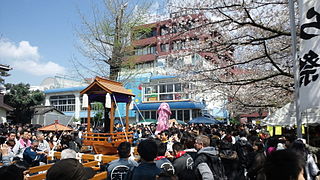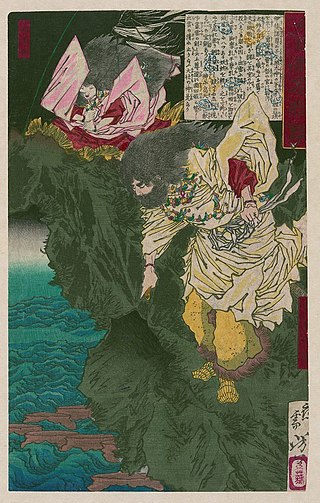
Musashi Province was a province of Japan, which today comprises Tokyo Metropolis, most of Saitama Prefecture and part of Kanagawa Prefecture. It was sometimes called Bushū (武州). The province encompassed Kawasaki and Yokohama. Musashi bordered on Kai, Kōzuke, Sagami, Shimōsa, and Shimotsuke Provinces.

Ōta Dōkan, also known as Ōta Sukenaga, was a Japanese samurai lord, poet and Buddhist monk. He took the tonsure as a Buddhist priest in 1478, and he also adopted the Buddhist name, Dōkan, by which he is known today. Dōkan is best known as the architect and builder of Edo Castle in what is today modern Tokyo; and he is considered the founder of the castle town which grew up around that Ōnin era fortress.

Wind chimes are a type of percussion instrument constructed from suspended tubes, rods, bells, or other objects that are often made of metal or wood. The tubes or rods are suspended along with some type of weight or surface which the tubes or rods can strike when they or another wind-catching surface are blown by the natural movement of air outside.

Ureshino is a city located in the western part of Saga Prefecture on the island of Kyushu, Japan. As of 31 May 2024, the city had an estimated population of 24,529 in 10075 households, and a population density of 190 persons per km2. The total area of the city is 126.41 km2 (48.81 sq mi).

Ōmiya is one of ten wards of the Saitama City, in Saitama Prefecture, Japan, and is located in the northeastern part of the city. As of 1 March 2021, the ward had an estimated population of 119,298 and a population density of 9,300 persons per km². Its total area was 12.80 square kilometres (4.94 sq mi). Although Urawa-ku is the governmental center of Saitama City, Ōmiya-ku is the most active commercial and business centre in both Saitama City and Saitama Prefecture thanks to its transport infrastructure, especially railways connected at Ōmiya Station.

Omikuji (御御籤/御神籤/おみくじ) are random fortunes written on strips of paper at Shinto shrines and Buddhist temples in Japan. Literally "sacred lot", these are usually received by making a small offering and randomly choosing one from a box, hoping for the resulting fortune to be good. As of 2024, vending machines sometimes dispense omikuji.

In Shinto and Buddhism in Japan, an ofuda or gofu (護符) is a talisman made out of various materials such as paper, wood, cloth or metal. Ofuda are commonly found in both Shinto shrines and Buddhist temples and are considered to be imbued with the power of the deities or Buddhist figures revered therein.

Hatsumōde is one of the major Japanese traditions of the new year, which is the first visit to a Buddhist temple or Shinto shrine visit of the Japanese New Year. Typically taking place on the first, second, or third day of the year, it is meant to bring a fresh start to the year. Hatsumōde is written with two kanji: the former means “first” and the latter means “visiting a shrine or temple.”

The Shinto Kanamara Matsuri is an annual Japanese festival held each spring at the Kanayama Shrine in Kawasaki, Japan. The exact dates vary: the main festivities fall on the first Sunday in April. The phallus, as the central theme of the event, is reflected in illustrations, candy, carved vegetables, decorations, and a mikoshi parade. The shrine is part of the Wakamiya Hachimangu Shrine and located near Kawasaki-Daishi Station.

Ōshū is a city located in Iwate Prefecture, Japan. As of 30 April 2020, the city had an estimated population of 114,620 and a population density of 120 persons per km2 in 45,728 households. The total area of the city is 993.30 square kilometres (383.52 sq mi). Ōshū is famous for its Maesawa Beef, numerous festivals, historic temples and shrines and Fujiwara no Sato, a theme park and movie lot based on the exploits of the Northern Fujiwaras in the 12th century. Many famous people claim Ōshū as their home, including Los Angeles Dodgers baseball player Shohei Ohtani and Ichiro Ozawa, the long-time leader of the Democratic Party of Japan.

Kawasaki, officially the Kawasaki City, is a city in Kanagawa Prefecture, Japan, one of the main cities of the Greater Tokyo Area and Keihin Industrial Area. It is the second most populated city in Kanagawa Prefecture after Yokohama, and the eighth most populated city in Japan.

Hon-Kawagoe Station is a passenger railway station on the Seibu Shinjuku Line located in the city of Kawagoe, Saitama, Japan, operated by the private railway operator Seibu Railway. This is one of three main stations of the city; the other two are Kawagoe Station and Kawagoeshi Station.

Kawagoeshi Station is a passenger railway station located in the city of Kawagoe, Saitama, Japan, operated by the private railway operator Tōbu Railway.

Usa Jingū (宇佐神宮), also known as Usa Hachimangū (宇佐八幡宮), is a Shinto shrine in the city of Usa in Ōita Prefecture in Japan. Emperor Ojin, who was deified as Hachiman-jin, is said to be enshrined in all the sites dedicated to him; and the first and earliest of these was at Usa in the early 8th century. The Usa Jingū has long been the recipient of Imperial patronage; and its prestige is considered second only to that of Ise.

One Hundred Famous Views of Edo is a series of 119 ukiyo-e prints begun and largely completed by the Japanese artist Hiroshige (1797–1858). The prints were first published in serialized form in 1856–59, with Hiroshige II completing the series after Hiroshige's death. It was tremendously popular and much reprinted.

Kushinadahime (櫛名田比売、くしなだひめ), also known as Kushiinadahime (奇稲田姫、くしいなだひめ) or Inadahime (稲田姫、いなだひめ) among other names, is a goddess (kami) in Japanese mythology and the Shinto faith. According to these traditions, she is one of the wives of the god Susanoo, who rescued her from the monster Yamata no Orochi. As Susanoo's wife, she is a central deity of the Gion cult and worshipped at Yasaka Shrine.

Time Bell Tower is a bell tower built in the center of Kawagoe, Japan. It is considered the symbol of the city.

Hikawa Shrine (氷川神社) is a Shinto shrine in Kawagoe, Saitama Prefecture, Japan. In order to separate it from Hikawa Shrine in Omiya Ward, Saitama City, it is often called Kawagoe Hikawa Shrine. Hikawa Shrine is known for its Reitaisai, or a festival considered the origin of Kawagoe festival, which was registered as a National Important Intangible Folk Cultural Property and listed as a UNESCO Intangible Cultural Heritage. It's also well known for its "corridor of windchiimes".

Nyoirin-ji (如意輪寺) is a Shingon temple in Ogōri, Fukuoka Prefecture, Japan. The temple, which is famed for its frog figurines, is commonly referred to as Kaeru-dera, while the formal name is Seieizan Nyoirin-ji(清影山如意輪寺).

Odai no kata, also known as Dai, Daishi, and Denzûin, was a Japanese noble lady from the Sengoku period.

























